Article contents
Effects on fluid balance, digestion and exercise response in Standardbred horses fed silage, haylage and hay
Published online by Cambridge University Press: 01 November 2008
Abstract
The objectives were to investigate the effects on fluid balance, digestion and exercise response in Standardbred horses in race training when feeding silage, haylage or hay-only diets. In experiment (exp) 1, five Standardbred geldings were fed forage-only diets: hay (82% dry matter, DM) and silage (45% DM) for 23 days in a crossover design. Total collection of faeces and urine was performed. In exp 2, six Standardbred geldings were fed forage-based diets: haylage (68% DM) and silage (41% DM) for 17 days in a crossover design. On day 17, an incremental interval exercise test was performed on an oval racetrack. In exp 1, horses drank more on the hay than on the silage diet, but total water intake (drinking+water in feed) was higher and resting values of total plasma protein (TPP) was lower on the silage diet. Total water output per day did not differ and therefore the estimated evaporation was larger on the silage than the hay diet. The apparent digestibility was higher on the silage than the hay diet. In exp 2, heart and respiratory rate, TPP and lactate and blood pH did not differ between the haylage and silage diets during and after the exercise test. In conclusion, feeding silage did not affect faecal water content, but apparent digestibility and estimated evaporative fluid loss were higher on the silage diet compared with the hay diet. The silage did not adversely affect the response to intensive exercise compared with haylage. However, the estimated higher evaporative fluid loss on the silage diet compared with the hay diet might cause an unnecessary challenge during more prolonged exercise.
Information
- Type
- Research Paper
- Information
- Copyright
- Copyright © Cambridge University Press 2009
References
- 13
- Cited by

